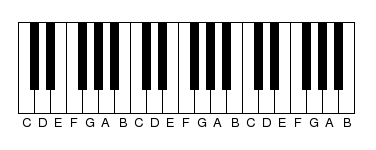- What do we mean by pitch?
- Have you ever wondered if a key is different from a pitch?
- What does it mean to be on-key and on-pitch?
Can you change keys? Are you sure that’s the right pitch? I remember my utter confusion the first time I heard those terms.
When I was brand new to this whole music and music theory thing, I often found the jargon overwhelming, so if you find yourself a little confused, don’t worry, we have all been there.
Let me help clear up some of the confusion by going through exactly what we mean by pitch and key and how those two things work together.
What Is the Difference Between Pitch and Key?
Well, to put it simply, pitch refers to the frequency of a sound, meaning that the sound wave moves at a specific frequency or speed that we can recognize as a note.
While key refers to the major or minor scale that a piece of music is based on. You can find the chords that will sound good with the key from that scale, e.g. C major.
A Closer Look at Pitch

As I mentioned, pitch refers to a particular frequency at which a sound wave moves. So let’s talk a little about frequency.
Frequency relates to the number of vibrations (crests of a sound wave) a sound makes per second. The faster the vibration, the higher the pitch. A slower vibration causes a much lower pitch.
For example, when you sing a high note or “play up high” on your instrument, your vocal cords or strings will vibrate more rapidly, and as a result, your pitch will be lower.
Okay, so if a pitch is a sound, then is that the same as a note?
Well, sort of, but not exactly.
Notes are to music what colors are to rainbows.
Okay, so we will start off with some basics.
In Western music theory, we break down all sounds into 12 notes. If we remove the incidentals (i.e. sharps and flats), we are left with eight notes or an octave.
Depending on the key (more on that later), each note can be tuned to a specific pitch. That pitch can be higher or lower without being off the note.
It’s sometimes helpful to think of pitch in terms of the color spectrum or rainbow. There are differences in the specific colors as you move through each part of the rainbow, but just because the orange has more red in it doesn’t mean your brain doesn’t see orange.
It’s kind of like that with pitch. You can tune to a given spectrum of pitch while still being on the right note. It will just be higher or lower within that frequency range.
Specific frequencies are assigned to specific notes and allow us to tune together. For example, in orchestral tuning, the note A is specifically at 440 Hrtz so that the entire orchestra has a reference note of exactly the same frequency to tune to.
What Is a Key?

Key, again in Western music theory, refers to the major or minor scale that a musical composition is based on. I mentioned that Western music can be divided into 12 notes when you include incidentals. These are the notes from C to the next C on the piano.
C – C#/Db – D – D#/Eb – E – F – F#/Gb – G – G#/Ab – A – A#/Bb – B – C
Each one of these notes above generates a set of notes that are interrelated to the tonal center of the scale. The note that the scale is based on (the tonic/tonal center), as well as whether the key is major or minor, will give you the diatonic notes of the scale.
Diatonic notes are consonant and sound good within the scale. They are harmonious with the tonal center. Notes that are non-diatonic create dissonance with the tonal center and sound “off.”
FAQs
Does changing the pitch change the key?
Not necessarily, although it certainly can. If you change the pitch of the tonic note on which the piece of music is based, then that would definitely change the key.
However, hitting a few notes that are not in the key at the wrong pitch doesn’t change the key. Changing the pitch of a single note does not produce a key change, unless that note is the tonic or root note of the piece.
Can you be on-key but off-pitch?
Yes, you definitely can. It is all about the relationship of musical tones. It is entirely possible to sing correctly in the key, but not sing all the correct pitches for the notes in that key. This will cause what we call dissonance with the note being played by the band. It is jarring and can be hard to listen to, but it doesn’t change the key.
Being “off-key,” on the other hand, means that you are completely in the wrong key. So, you are singing from the wrong tonal center. This means that every other note that you sing will clash with the band if they are in a different key. This is what we mean when we say that the music was off-key.
What does key mean in singing?
Key refers to the notes that are available within the scale that a given piece of music is written in. This has a major effect on vocalists, as our vocal range will affect the keys and note choices that we make.
If you find that a given piece is too high or too low for your range, then the band could transpose to a different key that would be more within your vocal range and easier to sing.


